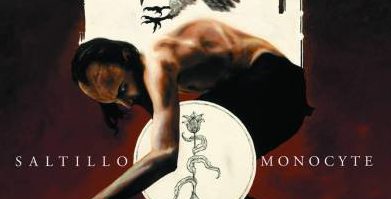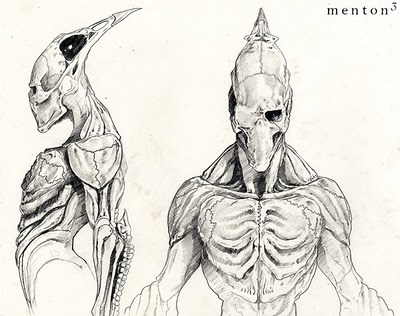Saltillo – known as Menton3 in the comic book scene and Menton John Matthews III in the real world – is the disgustingly talented multi-instrumentalist behind the 2011 album Ganglion and the 2012 album Monocyte, written as an accompaniment to his creator-owned graphic novel of the same name. Alongside being proficient on the cello, viola, violin, guitar, drums, piano, bass and banjo, Saltillo is an expert in a slew of electronics and a master audio sampler; it’s no wonder Saltillo is often cited as a band rather than an artist, considering how remarkable it is for such a complex album to be accomplished by one man.
His music is most frequently described as a combination of trip hop and neo-classical, incorporating orchestral elements with samples and electronica synths, although there are also clear goth influences. The synthesised, echoing female vocals on If Wishes Were Catholics and Veil are incredibly reminiscent of early 2000 gothic metal bands like Evanescence and Lacuna Coil, and are provided by Sarah Matthews, the artist’s wife and a deputy coroner in Chicago , Illinois whom he worked with in a previous music project called Sunday Munich. Saltillo is one of those musicians who was never classically trained, but has managed to learn and master many instruments to such a high quality that the casual listener could believe he had been. After releasing his first solo album Ganglion, he took a break from music to dedicate his efforts to his artwork, but his graphic novel Monocyte brought back the passion of music. After living for months in the world he had created, an externalised version of his inner landscape, he felt compelled to write the soundtrack of that world. For him, the experience was so fully immersive that the world needed both visual and audible representations.
The album begins with slow, mystic-sounding strings and echoed fragments of speech before bursting into a cacophony of electronic noises and prophetic speech. ABEO is only two and a half minutes and already manages to conjure the feel of a mystical post-apocalyptic land when Proxy kicks in with an industrial trip-hop vibe. The combination of classical music and Shakespearean poetry over synths swells into a dark and dramatic song which ebbs and flows and seamlessly drops back into the piano-heavy If Wishes Were Catholics. The haunting female vocals of Sarah Matthews make this song more easily accessible than many on the album, although it is still masterfully assembled with amazing attention to detail evident in the many layers of music, and Mrs Matthews voice adds pure human emotion to the music.
The Right of Action feels like a soulful dirge, a steady procession toward hopelessness which echoes the graphic novels theme of immortality as a tiring curse against humanity. The next track, They Do It All The Same, begins like a religious chant but falls into slow, trippy club music with the feel of Eastern religious music mystery; it’s clear that Saltillo is influenced by the iconography which religion holds in music. Gatekeepers is much more experimental again with a variety of synthesised noises being brought together like an orchestra while a British voice that sounds crackled as though on vinyl talks slowly throughout, first quoting Euripides’ The Medea, then Shakespeare’s Sonnet 144 (which is an appropriate lament of the artist’s struggle between hope and despair), finally finishing with a passage from Henry VI about the pointlessness of war. I Hate You is more frantic, bringing in sharp strings, canned laughter as on a TV show, and what sounds like Saltillo’s trusty banjo – not something you’d usually expect to hear in either neo-classical or trip hop music, but it works. The juxtaposition of American sitcom laughter and selections of Bible passages create unease, and this song leaves you feeling breathless in parts, only falling back occasionally to incorporate elements of previous songs before moving on again.
Philosophical double-speak accompanies gentle violins for the beginning of Forced Visions; this song is a lot lighter than many others on the album, offering a brief respite from tension without allowing the listener to fall out of the very specific feel that this album has. It steadily moves on into Hollow – which invokes both the sounds of a 18th century ballroom and a modern industrial band – and The Locus Priory which builds up the tension yet again, still maintaining the consistent feeling of overwhelming sadness and human suffering, weaving in snippets of earlier songs to give the album a thematic feel much more like the score to a film than a collection of songs.
A female vocalist accompanies the music in Veil, and it’s unclear whether this is Sarah Matthews again or someone else, as the credits only assign the vocals on If Wishes Were Catholics to her. This song starts quite differently from all the others, with an early 20th century blues vibe with just a hint of a Vincent Price horror film, but by the time the singing is brought in it becomes slightly more normal, a soulful vocal performance over the crashing and grinding of synthetic noises. Religious chanting and the lamentations of an old woman (drawn again from The Medea by Euripidies draw the listener into a false sense of security at the beginning of To Kill A King, as it soon bursts into heavy, rhythmic drumming like tribal dance music. Full of a positive energy and more peace than has been felt for this entire album, the song drains out to the crackled matron’s voice and lets the listener slowly slip away with a real sense of completion – a feeling that echoes the emotions of an immortal who has finally been given the eternal sleep they craved.
Although this album is an accompaniment to the graphic novel, there is no reason it should not be listened to alone. Saltillo is an incredibly talented and nuanced artist – in every meaning of the word – and while the score sets the tone beautifully for the graphic novel it is an album which has no problem standing on its own feet, should it be to your taste. A craving for experimental music, a willingness to listen to mostly instrumental songs and an appreciation for mood, style and technical greatness over catchiness and marketability are necessary for enjoying the album. It isn’t easy music; neither is the graphic novel an easy piece of literature to digest, but it’s completely worth it.

Monocyte is available in two formats; the CD released by Artoffact records, and the EP vinyl Monocyte: The Lapis Coil which features Proxy, Gatekeepers and the Locus Priory as well as remixes of If Wishes Were Catholics and The Right of Action, and the added bonus track Necromancy. All with artwork by the musician.



